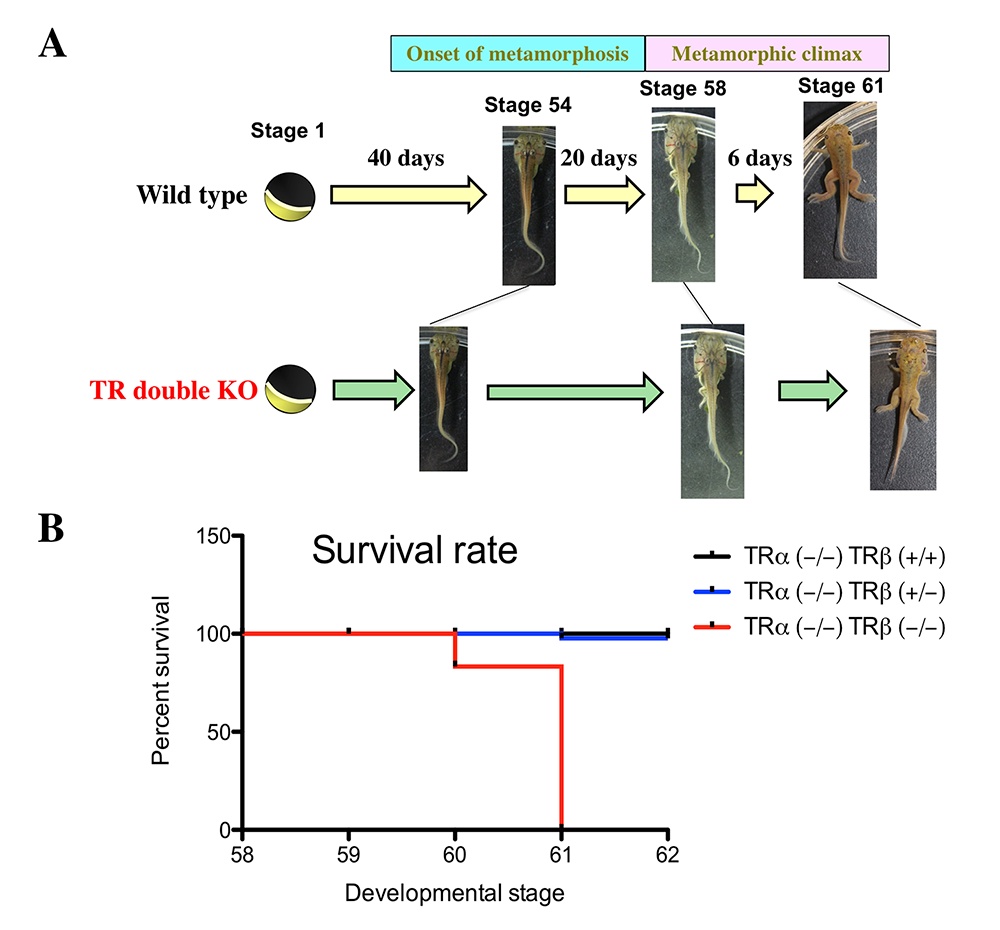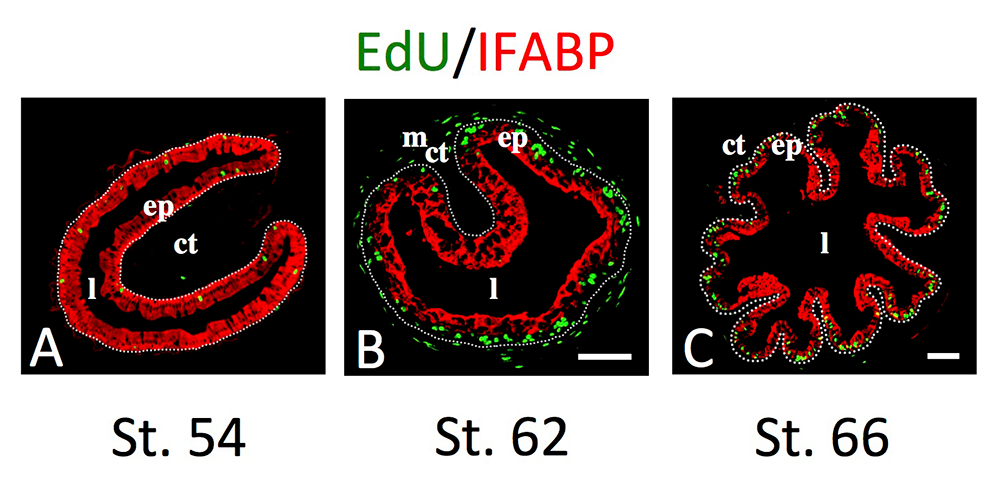Thyroid Hormone Regulation of Vertebrate Postembryonic Development

- Yun-Bo Shi, PhD, Head, Section on Molecular Morphogenesis
- Liezhen Fu, PhD, Staff Scientist
- Nga Luu, MS, Biologist
- Lusha Liu, PhD, Visiting Professor
- Lingyu Bao, MS, Visiting Fellow
- Wonho Na, PhD, Visiting Fellow
- Yuki Shibata, PhD, Visiting Fellow
- Yuta Tanizaki, PhD, Visiting Fellow
- Shouhong Wang, BS, Graduate Student
- Zhaoyi Peng, BS, Graduate Student
The laboratory investigates the molecular mechanisms of thyroid hormone (TH) function during postembryonic development, a period around birth in mammals when plasma TH levels peak. The main model is the metamorphosis of Xenopus laevis and X. tropicalis, two highly related species that offer unique but complementary advantages. The control of this developmental process by TH offers a paradigm to study gene function in postembryonic organ development. During metamorphosis, different organs undergo vastly different changes. Some, like the tail, undergo complete resorption, while others, such as the limb, are developed de novo. The majority of the larval organs persist through metamorphosis but are dramatically remodeled to function in a frog. For example, tadpole intestine is a simple tubular structure consisting primarily of a single layer of larval epithelial cells. During metamorphosis, it is transformed into an organ with a multiply folded adult epithelium surrounded by elaborate connective tissue and muscles, by a process that involves specific larval epithelial cell death and de novo development of the adult epithelial stem cells, followed by their proliferation and differentiation. The wealth of knowledge from past research and the ability to manipulate amphibian metamorphosis both in vivo, by using genetic approaches or hormone treatment of whole animals, and in vitro, in organ cultures, offer an excellent opportunity, first, to study the developmental function of TH receptors (TRs) and their underlying mechanisms in vivo and, second, to identify and functionally characterize genes that are critical for organogenesis, in particular, for the formation of the adult intestinal epithelial stem cells, during postembryonic development in vertebrates. A major recent focus has been to make use of the TALEN and CRISPR/Cas9 technologies to knockdown or knockout the endogenous genes for functional analyses. In addition, the recent improvements in X. tropicalis genome annotation allow us to carry out RNA-Seq and chromatin-immunoprecipitation (ChIP)-Seq analyses at the genome-wide level. We also complement our frog studies by investigating the genes found to be important for frog intestinal stem cell development in the developing mouse intestine by making use of the ability to carry out conditional knockout.
Analysis of trα-knockout tadpoles reveals that the activation of the-cell cycle program is involved in TH–induced larval epithelial cell death and adult intestinal stem cell development during Xenopus tropicalis metamorphosis.
We recently knocked out the TR genes trα and trβ, individually or both, in X. tropicalis and analyzed the knockouts' effect on tadpole development and the metamorphosis of various organs. Of interest is intestinal remodeling, which involves near-complete degeneration of the larval epithelium through apoptosis. Concurrently, adult intestinal stem cells are formed de novo and subsequently give rise to the self-renewing adult epithelial system, resembling intestinal maturation around birth in mammals. We observed that both trα and trβ play important roles in intestinal remodeling. To understand the underlying molecular mechanism, we recently studied the function of endogenous Trα in the tadpole intestine by using knockout animals and RNA-Seq analysis [Reference 1]. We observed that removing endogenous Trα caused defects in intestinal remodeling, including drastically reduced larval epithelial cell death and adult intestinal stem cell proliferation. Using RNA-Seq on intestinal RNA from pre-metamorphic wild-type and trα–knockout tadpoles treated with or without TH for one day and prior to any detectable TH–induced cell death and stem-cell formation in the tadpole intestine, we identified over 1,500 genes regulated by TH treatment of the wild-type but not of trα–knockout tadpoles. Gene ontology and biological-pathway analyses revealed that, surprisingly, these Trα–regulated genes were highly enriched with cell cycle–related genes, in addition to genes related to stem cells and apoptosis. Our findings suggest that Trα–mediated TH–activation of the cell-cycle program is involved in larval epithelial cell death and adult epithelial stem-cell development during intestinal remodeling. We carried out a comprehensive gene-expression analysis in the notochord during metamorphosis using RNA-Seq analyses of whole tail at stage 60 before any noticeable reduction in tail length, whole tail at stage 63 when the tail length is reduced by about one half, and the rest of the tail at stage 63 after removing the notochord. This allowed us to identify many notochord-enriched, metamorphosis-induced genes at stage 63 [Reference 1]. Future studies on these genes should help determine whether they are regulated by trβ and play any roles in notochord regression.
We also discovered differential regulation of several matrix metalloproteinases (MMPs), which are known to be upregulated by TH and thought to play a role in tissue resorption by degrading the extracellular matrix (ECM). In particular, Mmp9-TH and Mmp13 are extremely highly expressed in the notochord compared with the rest of the tail. In situ hybridization analyses showed that these MMPs are expressed in the outer sheath cells and/or the connective tissue sheath surrounding the notochord. Our findings suggest that high levels of trß expression in the notochord specifically upregulate the MMPs, which in turn degrades the ECM, leading to the collapse of the notochord and its subsequent resorption during metamorphosis.
A role of endogenous histone acetyltransferase steroid hormone receptor coactivator 3 (Src3) in TH signaling during Xenopus intestinal metamorphosis
We showed previously that, during metamorphosis, liganded TR recruits coactivator complexes that include Src3, which is a histone acetyltransferase, to TH–responsive promoters. To investigate the functions of endogenous coactivators such as Src3 during metamorphosis, we generated X. tropicalis animals lacking a functional src3 gene and analyzed the resulting phenotype [Reference 2]. While removing src3 had no apparent effect on external development and animal gross morphology, the src3−/− tadpoles displayed a reduction in the acetylation of histone H4 in the intestine comparing with that in wild-type animals. Furthermore, the expression of TR target genes was also reduced in src3−/− tadpoles during intestinal remodeling. Importantly, intestinal remodeling during natural and TH–induced metamorphosis was inhibited/delayed in src3−/− tadpoles and included reduced adult intestinal stem-cell proliferation and apoptosis of larval epithelial cells. Our results thus demonstrate that, during intestinal remodeling, Src3 is a critical component of the TR–signaling pathway in vivo.
Evolutionary divergence in tail regeneration between X. laevis and X. tropicalis
Tissue regeneration is of fast-growing importance in the development of biomedicine, particularly in organ replacement therapies. Unfortunately, many human organs cannot regenerate. As many tadpole organs can, the auran X. laevis has been used as a model to study regeneration. In particular, the tail, which consists of many axial and paraxial tissues, such as spinal cord, dorsal aorta, and muscle, commonly present in vertebrates, can fully regenerate when amputated at late embryonic stages and at most of the tadpole stages. Interestingly, between stage 45, when feeding begins, and stage 47, the pseudo-tetraploid X. laevis tail cannot regenerate after amputation. This period, termed the “refractory period,” has been known for about 20 years. The underlying molecular and genetic bases are unclear, in part because it is difficult to carry out genetic studies in this pseudo-tetraploid species. The availability of the highly related but diploid X. tropicalis offers an opportunity to study the molecular and genetic mechanisms of tail regeneration during the refractory period. We compared tail regeneration between X. laevis and X. tropicalis and found, surprisingly, that X. tropicalis lacked the refractory period [Reference 3]. Further molecular and genetic studies, more feasible in this diploid species, should reveal the basis for this evolutionary divergence in tail regeneration between two related species and facilitate the understanding of how tissue regenerative capacity is controlled. In addition, it is well known that many tadpole tissues lose their regenerative capacity during metamorphosis, suggesting a role for TH and TR in regeneration. Making use of our recently generated tr–knockout animals, we also plan to investigate whether and how TH and TR regulate tissue regeneration. Such studies should have important implications for human regenerative medicine.
The TR is essential for larval epithelial apoptosis and adult epithelial stem-cell development but not for adult intestinal morphogenesis during X. tropicalis metamorphosis.
We recently generated TR double-knockout (TRDKO) X. tropicalis animals and reported that TR is essential for the completion of metamorphosis. Furthermore, TRDKO tadpoles are stalled at the climax of metamorphosis before eventual death. To investigate the underlying defects resulting from TRDKO, we analyzed the intestine at the climax of metamorphosis in wild-type and TRDKO animals at the climax of metamorphosis [Reference 4]. We showed that the TRDKO intestine lacked larval epithelial cell death and adult stem-cell formation/proliferation during natural metamorphosis. Interestingly, TRDKO tadpole intestine displayed premature formation of adult-like epithelial folds and muscle development. In addition, TH treatment of premetamorphic TRDKO tadpoles failed to induce any metamorphic changes in the intestine. Furthermore, RNA-Seq analysis revealed that TRDKO altered the expression of many genes in biological pathways, such as Wnt signaling and the cell cycle, that likely underlie the inhibition of larval epithelial cell death and adult stem-cell development caused by removing both TR genes. Our data suggest that liganded TR is required for larval epithelial cell degeneration and adult stem-cell formation, whereas unliganded TR prevents precocious adult tissue morphogenesis such as smooth muscle development and epithelial folding in the intestine.
Figure 1. Effects of TR double KO on developmental rate. TR double KO leads to premature initiation of metamorphosis but slows metamorphic progress and causes lethality at the metamorphic climax.
A. TR double KO animals take a shorter time to reach the onset of metamorphosis (stage 54), indicating accelerated premetamorphic development. Once metamorphosis begins, the KO animals take longer to reach the beginning of metamorphic climax (stage 58) and also develop more slowly during the climax stages, between stages 58 and 61. The length of each indicates the relative time needed for development between two adjacent stages.
B. Tadpoles without any TR die during the climax of metamorphosis. The tadpoles of mixed genotypes at stage 58 were allowed to develop to stage 62 and were genotyped at stage 62 or when they died during this developmental period. The survival rate for each of the three genotypes, trα–/–trβ+/+, trα–/–trβ+/–, and trα–/–trβ–/–, was thus obtained and plotted. Note that no double knockout tadpoles developed to stage 62 and that a single copy of trβ+/– was sufficient for the animal to complete metamorphosis and develop into a reproductive adult.
TH directly activates mitochondrial fission process 1 (mtfp1) gene transcription during adult intestinal stem-cell development and proliferation in X. tropicalis.
TH functions by regulating target-gene expression through TRs. Thus, identification and characterization of TH target genes are essential toward understanding how TH regulates adult intestinal stem-cell development during metamorphosis. We previously identified many candidate TR target genes during X. tropicalis intestinal metamorphosis, a process that involves apoptotic degeneration of most of the larval epithelial cells and de novo development of adult epithelial stem cells. Among such putative TR target genes is mitochondrial fission process 1 (mtfp1), a nuclear-encoded mitochondrial gene. Our recent studies showed that mtfp1 gene expression peaked in the intestine during both natural and TH–induced metamorphosis when adult epithelial stem-cell development and proliferation took place. Furthermore, mtfp1 contained a TH–response element (TRE) within the first intron, which was bound by TR to mediate TH–induced local histone H3K79 methylation and RNA polymerase recruitment in the intestine during metamorphosis. Additionally, we demonstrated that the mtfp1 promoter could be activated by TH in a reconstituted frog oocyte system in vivo and that the activation is dependent on the intronic TRE. The findings suggest that TH activates the mtfp1 gene directly via the intronic TRE and that mtfp1 in turn facilitates adult intestinal stem-cell development/proliferation by affecting the mitochondrial fission process.
Figure 2. Intestinal metamorphosis involves the formation of clusters of proliferating, undifferentiated epithelial cells at the climax.
Tadpoles at premetamorphic stage 54 (A), climax, stage 62 (B), and the end of metamorphosis, stage 66 (C) were injected with 5-ethynyl-2′-deoxyuridine (EdU) one hour before sacrifice. Cross-sections of the intestine from the resulting tadpoles were double-stained by EdU labeling of newly synthesized DNA and by immunohistochemistry of IFABP (intestinal fatty acid–binding protein), a marker for differentiated epithelial cells. The dotted lines depict the epithelium-mesenchyme boundary. Note that there are few EdU–labeled proliferating cells in the epithelium and that they express IFABP at premetamorphosis (A) and increase in the form of clustered cells (proliferating adult stem cells), which lack IFABP at the climax of metamorphosis (B). At the end of metamorphosis, EdU–labeled proliferating cells are localized mainly in the troughs of the epithelial folds, where IFABP expression is low (C). ep, epithelium; ct, connective tissue; m, muscles; l, lumen.
The protein arginine methyltransferase 1 regulates cell proliferation and differentiation in adult mouse adult intestine.
Tadpoles at premetamorphic stage 54 (A), climax (B, stage 62), and the end of metamorphosis (C, stage 66) were injected with 5-ethynyl-2′-deoxyuridine (EdU) one hour before sacrifice. Cross-sections of the intestine from the resulting tadpoles were double-stained by EdU labeling of newly synthesized DNA and by immunohistochemistry of IFABP (intestinal fatty acid–binding protein), a marker for differentiated epithelial cells. The dotted lines depict the epithelium-mesenchyme boundary. Note that there are few EdU–labeled proliferating cells in the epithelium and that they express IFABP at premetamorphosis (A) and increase in the form of clustered cells (proliferating adult stem cells), which lack IFABP at the climax of metamorphosis (B). At the end of metamorphosis, EdU–labeled proliferating cells are localized mainly in the troughs of the epithelial folds, where IFABP expression is low (C). ep, epithelium; ct, connective tissue; m, muscles; l, lumen.
Additional Funding
- Japan Society for the Promotion of Science (JSPS) fellowships for Drs. Yuta Tanizaki and Yuki Shibata
- Awards from the China Scholarship Council (CSC) to Drs. Shouhong Wang and Lusha Liu
Publications
- Tanizaki Y, Shibata Y, Zhang H, Shi Y-B. Analysis of thyroid hormone receptor a knockout tadpoles reveals that the activation of cell cycle program is involved in thyroid hormone-induced larval epithelial cell death and adult intestinal stem cell development during Xenopus tropicalis metamorphosis. Thyroid 2021;31:128–142.
- Tanizaki Y, Bao L, Shi B, Shi Y-B. A role of endogenous histone acetyltransferase steroid hormone receptor coactivator (SRC) 3 in thyroid hormone signaling during Xenopus intestinal metamorphosis. Thyroid 2021;31:692–702.
- Wang S, Shi Y-B. Evolutionary divergence in tail regeneration between Xenopus laevis and Xenopus tropicalis. Cell Biosci 2021;11:71.
- Shibata Y, Tanizaki Y, Zhang H, Lee H, Dasso M, Shi Y-B. Thyroid hormone receptor is essential for larval epithelial apoptosis and adult epithelial stem cell development but not adult intestinal morphogenesis during Xenopus tropicalis metamorphosis. Cells 2021;10:536.
- Xue L, Bao L, Roediger J, Su Y, Shi B, Shi Y-B. Protein arginine methyltransferase 1 regulates cell proliferation and differentiation in adult mouse adult intestine. Cell Biosci 2021;11:113.
Collaborators
- Steven Coon, PhD, Molecular Genomics Core, NICHD, Bethesda, MD
- Mary Dasso, PhD, Section on Cell Cycle Regulation, NICHD, Bethesda, MD
- Eiichi Hinoi, PhD, Kanazawa University Graduate School, Kanazawa, Japan
- James Iben, PhD, Molecular Genomics Core, NICHD, Bethesda, MD
- Jianping Jiang, PhD, Chengdu Institute of Biology, Chinese Academy of Sciences, Chengdu, China
- Tianwei Li, PhD, Molecular Genomics Core, NICHD, Bethesda, MD
- Susan Mackem, MD, PhD, Cancer and Developmental Biology Laboratory, Center for Cancer Research, NCI, Frederick, MD
- Keisuke Nakajima, PhD, Amphibian Research Center, Hiroshima University, Hiroshima, Japan
- Bingyin Shi, MD, Xi’an Jiaotong University School of Medicine, Xi'an, China
- Guihong Sun, PhD, Wuhan University School of Medicine, Wuhan, China
- Peter Taylor, PhD, University of Dundee, Dundee, United Kingdom
- Henry Zhang, PhD, Bioinformatics and Scientific Programming Core, NICHD, Bethesda, MD
Contact
For more information, email shi@helix.nih.gov or visit https://smm.nichd.nih.gov.




